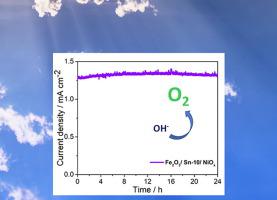Journal of Catalysis ( IF 7.3 ) Pub Date : 2020-08-21 , DOI: 10.1016/j.jcat.2020.08.014 Anelisse B. Silva , Camila D.F. da Silva , Flavio L. Souza , Francisco W.S. Lucas , Fabio H.B. Lima

|
Sn- and NiOx-modified Fe2O3 (hematite) films were entirely synthesized via electrodeposition procedure, followed by thermal treatment, and tested as photo-electrocatalyst for water splitting, in alkaline electrolyte. The optimization of the Sn and NiOx electrodeposition loadings on Fe2O3 produced a maximum photocurrent density of 1.35 mA cm−2 at 1.23 V (vs. RHE), with the highest shift on the reaction onset potential, representing a large improvement in relation to bare hematite. Long-term photoelectrolysis studies of the Fe2O3/Sn-10/NiOx at 1.23 V showed that the photocurrent density remained stable for at least 24 h. The assessment of the results from the calculations of charge separation (ƞsep) and charge injection (ƞcat) efficiencies revealed an improvement in both parameters, with the addition of tin into hematite. This was ascribed to its beneficial effect on lowering the charge recombination of the photogenerated charge carriers on grain-boundaries and on the hematite/electrolyte interface. Additionally, it was evidenced that NiOx was more important on the increase in the charge injection, since it is a hole collector, acting as co-catalyst, which improves charge transfer rate at the interface with the electrolyte. The outcome of the Mott-Schottky analysis displayed a negative shift of the flat band potentials (Efb) for both, Sn- and NiOx-modified photo-electrocatalysts, due to the passivation of the surface states, and this was in agreement with the mathematical fitting of the curves obtained via photoelectrochemical impedance spectroscopy (PEIS) measurements. The present findings clearly showed that, by allowing a fine-tuning of the amount of the metal modifiers and with an efficient deposition at functional sites of the hematite, this electrodeposition method is a promising strategy to boost hematite performance as photo-electrocatalyst.
中文翻译:

全电化学合成的氧化锡和氧化镍改性的赤铁矿作为太阳能驱动水分解的光催化剂阳极
Sn-和NiO x改性的Fe 2 O 3(赤铁矿)薄膜是通过电沉积过程完全合成的,然后进行热处理,并在碱性电解质中作为光分解水的光催化剂进行测试。对Fe 2 O 3上的Sn和NiO x电沉积负载的优化产生了在1.23 V(vs. RHE)时最大光电流密度为1.35 mA cm -2,反应开始电位的最大变化,表明与赤铁矿有关。Fe 2 O 3 / Sn-10 / NiO x的长期光电解研究在1.23V的电压下显示光电流密度保持稳定至少24小时。从电荷分离(ƞ的计算结果的评估月)和电荷注入(ƞ猫)效率揭示了这两个参数的改善,在添加锡的成赤铁矿。这归因于其对降低光生载流子在晶界和赤铁矿/电解质界面上的电荷复合的有益作用。另外,据证明NiO x对于电荷注入的增加,更重要的是,因为它是空穴收集器,起助催化剂的作用,可提高与电解质界面的电荷转移速率。Mott-Schottky分析的结果显示,由于表面状态的钝化,Sn和NiO x改性的光催化剂的平带电势(E fb)均出现负向变化,这与通过获得的曲线的数学拟合光电化学阻抗谱(PEIS)测量。本发现清楚地表明,通过允许微调金属改性剂的量并在赤铁矿的功能位点处有效沉积,该电沉积方法是提高赤铁矿作为光电催化剂性能的一种有前途的策略。

























 京公网安备 11010802027423号
京公网安备 11010802027423号